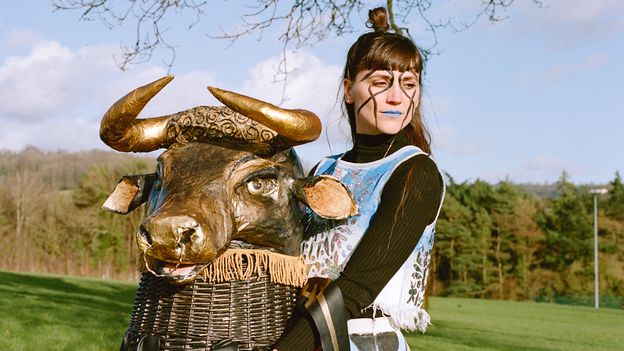
The rowdiness at Ottery St Mary, however, may sound like a tea party compared to the mayhem that is Haxey Hood, in North Lincolnshire . In this night-long event, opposing villages attempt to get hard cylinders of leather – the “Hoods” – into one of the four pubs in ei ther Haxey or the nearby village of Westwoodside. “They lock down into a rugby scrum called the Sway – and the Sway can go on all night,” says Costin. The event takes place in January. “I remember looking across the village and seeing 300 men locked into each other, in this snow-covered field, with the steam rising off them,” he says. “It’s very visceral and archaic. You’re witnessing something primeval.”
Haxey Hood’s (professed) origins lie in the 14th Century, when Lady de Mowbray, the wife of a local landowner, was out riding. As she went over a hill, her silk riding hood was blown away by the wind. Thirteen farm workers chased the hood all over the field, before it was finally caught by one. Too shy to hand it back himself, he gave it to one of the others to hand back to the Lady. Amused, she named the worker who had returned the hood the “Lord”, and the one who had caught the hood, the “Fool”, leading to two of the key characters in the tradition, alongside 11 mercurial Boggins, “custodians of the tradition,” says Hield. “They’re there to keep it safe – but also make it happen.” Lady de Mowbray is then said to have donated land to the workers – on condition that the chase for the hood would be re-enacted each year.
While St Ottery barrellers wear heavy gloves and practical clothing, costume is key in Haxey Hood. The Lord and chief Boggin are dressed in red hunting coats and top hats covered in flowers and badges; the Lord also carries a staff of office, made from twelve willow wands with one more upside-down in the centre, representing the twelve apostles and Judas. His face smeared with soot, the Fool is covered in multicoloured scraps of materials. He leads the procession, beating nearby parishioners away with a bran-stuffed sock and claiming the right to kiss any woman along the way. His welcome speech ends with a traditional rhyme: “hoose agen hoose, toon agen toon, if a man meets a man knock ‘im doon, but doan’t ‘ot ‘im” translated as: “house against house, town against town, if a man meets a man, knock him down but don’t hurt him.”
Deeper meanings
Rowdiness aside, every folk custom – in every community around the world – is unique to its time and place. “People really are passionate about them,” says the University of Sheffield’s Professor Fay Hield, director of the Contemporary Folklore Research Centre. “And the meanings are far deeper than you’d grasp simply by attending. A lot of understanding is held within the community. “Someone coming from the North to an event in the South, for example, wouldn’t get all the references.” What customs do have in common, she says, are the “purposes they serve”: as ways of connecting and responding to the physical, natural and societal worlds around them.